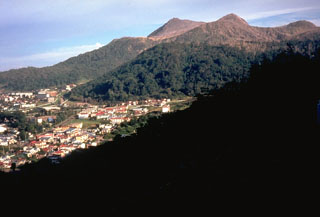Report on Toya (Japan) — January 1979
Scientific Event Alert Network Bulletin, vol. 4, no. 1 (January 1979)
Managing Editor: David Squires.
Toya (Japan) Voluminous steaming continues; no explosions in 3 months
Please cite this report as:
Global Volcanism Program, 1979. Report on Toya (Japan) (Squires, D., ed.). Scientific Event Alert Network Bulletin, 4:1. Smithsonian Institution. https://doi.org/10.5479/si.GVP.SEAN197901-285030
Toya
Japan
42.544°N, 140.839°E; summit elev. 733 m
All times are local (unless otherwise noted)
No explosions have occurred since 27 October 1978, although voluminous steam emission has been continuous. The average number of seismic events per day was 84 in December, up slightly from 79/day in November.
Geological Summary. Usuzan, one of Hokkaido's most well-known volcanoes, is a small stratovolcano located astride the southern topographic rim of the 110,000-year-old Toya caldera. The center of the 10-km-wide, lake-filled caldera contains Nakajima, a group of forested Pleistocene andesitic lava domes. The summit of the basaltic-to-andesitic edifice of Usu is cut by a somma formed about 20-30,000 years ago when collapse of the volcano produced a debris avalanche that reached the sea. Dacitic domes erupted along two NW-SE-trending lines fill and flank the summit caldera. Three of these domes, O-Usu, Ko-Usu and Showashinzan, along with seven crypto-domes, were erupted during historical time. The 1663 eruption of Usu was one of the largest in Hokkaido during historical time. The war-time growth of Showashinzan from 1943-45 was painstakingly documented by the local postmaster, who created the first detailed record of growth of a lava dome.
Information Contacts: JMA, Tokyo.

